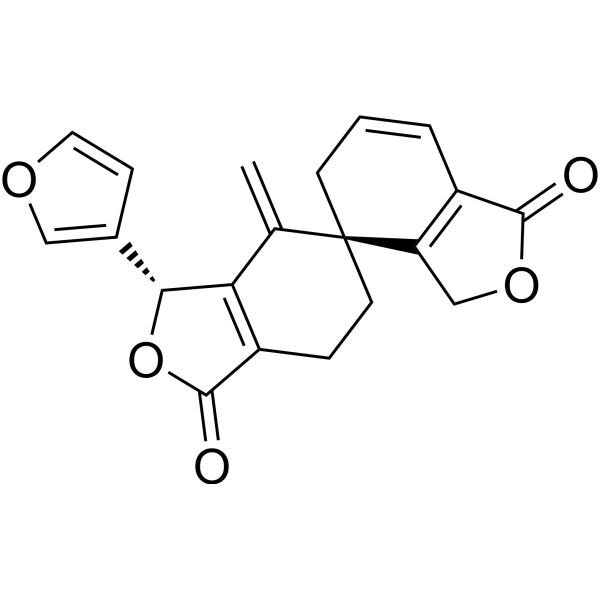Salvileucalin ACAS# 1053241-84-1 |

Quality Control & MSDS
Package In Stock
Number of papers citing our products

| Cas No. | 1053241-84-1 | SDF | Download SDF |
| PubChem ID | N/A | Appearance | Powder |
| Formula | C20H16O5 | M.Wt | 336.34 |
| Type of Compound | Diterpenoids | Storage | Desiccate at -20°C |
| Solubility | Soluble in Chloroform,Dichloromethane,Ethyl Acetate,DMSO,Acetone,etc. | ||
| General tips | For obtaining a higher solubility , please warm the tube at 37 ℃ and shake it in the ultrasonic bath for a while.Stock solution can be stored below -20℃ for several months. We recommend that you prepare and use the solution on the same day. However, if the test schedule requires, the stock solutions can be prepared in advance, and the stock solution must be sealed and stored below -20℃. In general, the stock solution can be kept for several months. Before use, we recommend that you leave the vial at room temperature for at least an hour before opening it. |
||
| About Packaging | 1. The packaging of the product may be reversed during transportation, cause the high purity compounds to adhere to the neck or cap of the vial.Take the vail out of its packaging and shake gently until the compounds fall to the bottom of the vial. 2. For liquid products, please centrifuge at 500xg to gather the liquid to the bottom of the vial. 3. Try to avoid loss or contamination during the experiment. |
||
| Shipping Condition | Packaging according to customer requirements(5mg, 10mg, 20mg and more). Ship via FedEx, DHL, UPS, EMS or other couriers with RT, or blue ice upon request. | ||

Salvileucalin A Dilution Calculator

Salvileucalin A Molarity Calculator
| 1 mg | 5 mg | 10 mg | 20 mg | 25 mg | |
| 1 mM | 2.9732 mL | 14.8659 mL | 29.7318 mL | 59.4636 mL | 74.3295 mL |
| 5 mM | 0.5946 mL | 2.9732 mL | 5.9464 mL | 11.8927 mL | 14.8659 mL |
| 10 mM | 0.2973 mL | 1.4866 mL | 2.9732 mL | 5.9464 mL | 7.433 mL |
| 50 mM | 0.0595 mL | 0.2973 mL | 0.5946 mL | 1.1893 mL | 1.4866 mL |
| 100 mM | 0.0297 mL | 0.1487 mL | 0.2973 mL | 0.5946 mL | 0.7433 mL |
| * Note: If you are in the process of experiment, it's necessary to make the dilution ratios of the samples. The dilution data above is only for reference. Normally, it's can get a better solubility within lower of Concentrations. | |||||

Calcutta University

University of Minnesota

University of Maryland School of Medicine

University of Illinois at Chicago

The Ohio State University

University of Zurich

Harvard University

Colorado State University

Auburn University

Yale University

Worcester Polytechnic Institute

Washington State University

Stanford University

University of Leipzig

Universidade da Beira Interior

The Institute of Cancer Research

Heidelberg University

University of Amsterdam

University of Auckland

TsingHua University

The University of Michigan

Miami University

DRURY University

Jilin University

Fudan University

Wuhan University

Sun Yat-sen University

Universite de Paris

Deemed University

Auckland University

The University of Tokyo

Korea University
- Arundanine
Catalog No.:BCX1775
CAS No.:618852-71-4
- (±)-7-epi-Kadsurenone
Catalog No.:BCX1774
CAS No.:245648-20-8
- 6,7-Dihydrosalviandulin E
Catalog No.:BCX1773
CAS No.:1983982-37-1
- Dugesin B
Catalog No.:BCX1772
CAS No.:760973-66-8
- Quercetin 3-O-β-D-xylofuranosyl-(1→2)-β-D-galactopyranoside
Catalog No.:BCX1771
CAS No.:1181635-91-5
- (7R,8S,8′R)-4,7-Dihydroxy-3,3′,4′-trimethoxyl-9-oxo dibenzylbutyrolactone lignan-4-O-β-D-glucopyrano...
Catalog No.:BCX1770
CAS No.:1807808-90-7
- Salvileucantholide
Catalog No.:BCX1769
CAS No.:158994-33-3
- Dugesin C
Catalog No.:BCX1768
CAS No.:1403505-97-4
- Poricoic acid H
Catalog No.:BCX1767
CAS No.:415724-85-5
- Donasine
Catalog No.:BCX1766
CAS No.:1017237-81-8
- Polyfuroside
Catalog No.:BCX1765
CAS No.:108886-03-9
- 2,4-Dihydroxy-allylbenzene-2-O-β-D-glucopyranoside
Catalog No.:BCX1764
CAS No.:1416564-61-8
- Hancinone D
Catalog No.:BCX1777
CAS No.:104973-90-2
- 3-Hydroxyirisquinone
Catalog No.:BCX1778
CAS No.:100205-29-6
- Quercetin 3-O-(6′′-caffeoyl)-β-D-galactopyranoside
Catalog No.:BCX1779
CAS No.:316354-12-8
- Quercetin 3-galactosyl(1→2)rhamnoside
Catalog No.:BCX1780
CAS No.:189135-70-4
- 6,7-Dehydrodugesin A
Catalog No.:BCX1781
CAS No.:1542141-27-4
- Qianhucoumarin B
Catalog No.:BCX1782
CAS No.:152615-14-0
- Qianhucoumarin C
Catalog No.:BCX1783
CAS No.:152615-15-1
- 6-Methoxykaempferol 3-O-β-D-glucopyranosyl-(1 →2)-β-D-glucopyranosyl-7-O-β-D- glucopyranoside
Catalog No.:BCX1784
CAS No.:2364631-99-0
- 6-Methoxykaemferol-3-O-β-D-glucosyl (1'″→2″)-β-D-glucopyranosyl-(6″″-(E)-caffeoyl) -7-O-β-D-glucopyr...
Catalog No.:BCX1785
CAS No.:1005416-14-7
- 3-O-Methylquercetin 7-O-β-D-glucopyranosyl-4′-O-β-D-glucopyranoside
Catalog No.:BCX1786
CAS No.:47858-32-2
- Pedunculosumoside F
Catalog No.:BCX1787
CAS No.:1283600-08-7
- Ketologanin
Catalog No.:BCX1788
CAS No.:152-91-0
Structure of salvioccidentalin, a diterpenoid with a rearranged neo-clerodane skeleton from Salvia occidentalis.[Pubmed:22041884]
Molecules. 2011 Oct 31;16(11):9109-15.
From the aerial parts of Salvia occidentalis (Labiatae) a new diterpenoid with a rearranged neo-clerodane skeleton was isolated. This new compound was named salvioccidentalin and its structure was established by spectroscopic means. A probable biogenetic relationship with salvigenolide from S. fulgens and Salvileucalin A and spiroleucantholide from Salvia leucantha is proposed.
Salvileucalin B, a novel diterpenoid with an unprecedented rearranged neoclerodane skeleton from Salvia leucantha Cav.[Pubmed:18788744]
Org Lett. 2008 Oct 16;10(20):4429-32.
Salvileucalin B (2), having an unprecedented rearranged neoclerodane skeleton, was isolated from the aerial parts of Salvia leucantha Cav. (Labiatae) along with Salvileucalin A (1). The absolute structures were elucidated by spectroscopic analysis, X-ray crystallographic analysis, and vibrational circular dichroism. Compound 2 represents a novel neoclerodane, characterized by a tricyclo[3.2.1.0 (2,7)]octane substructure incorporating the exocyclic C-20 methylene of 1. This molecule exerted cytotoxic activity against A549 and HT-29 cells with IC50 values of 5.23 and 1.88 microg/mL, respectively.


